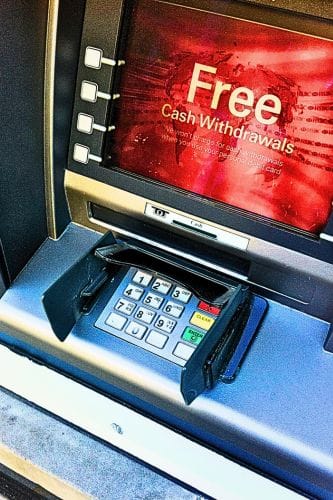The other day my wife asked me what the best card for a trip to Dubai might be. There is a daughter in Dubai about to have a baby, and she is looking forward to becoming a grandma – the wife, not the daughter!
I considered Wise to be a good choice, although there are clearly other options, but that’s not the point.
We sat down on the settee and downloaded the app, on the iPhone and the iPad, and we kicked off the process on the iPad – bigger writing – but transferred to the iPhone for the Proof of Identity, because of the rubbish camera experience on the iPad!
Identity validation: not for the faint-hearted
Taking a picture of her Passport appeared to be a bit of a black art, which is why we swapped to the iPhone, but then fitting her face in the oval space provided, without overhanging hair and without glasses so she couldn’t see if the hair was overhanging or not, made taking a picture of the Passport something more suited to the IT skills of a 10-year-old.
We persevered and we managed it, and the response was rapid and accurate – it was indeed her!
We had access to a Wise account, and I showed her how to set up a UAE Dirham wallet – is that the right terminology? I feel like I should be down more with the kids.
Open Banking: nice
We were using her iPhone, which is where all her banking apps sit, and we thought that since we had a Sterling wallet and a Dirham wallet, we should try and top up the Sterling wallet.
Hit the “+” button on the app and tell it how much you want to add. We thought we’d try a tenner, just to get the hang of it. Which of the following is your bank? She selected Nationwide, as that’s where the money was, and we were off. The screens bounced backwards and forwards and sideways as the Wise pages were overwhelmed by the Nationwide page confirming that she was the real deal. Nationwide asked her the usual A2A fraud questions, and we convinced the app that we knew what we were doing. She was then bounced back, with the same ups and downs and lefts and rights, to the Wise app where a quick refresh revealed an account balance of £10.
We did a second transaction – which this time showed the Nationwide as the default option so no need to scroll through the list of supported banks – and were bounced backwards and forwards just like previously. She confirmed that she wasn’t being scammed and bounced all the way back to Wise. A quick refresh indicated that the Sterling wallet now contained twenty pounds.
We did it again for a larger sum and then we converted some of the Sterling to Dirhams, and it was simple, even for an old person! No issues with Wise.
And to be honest, no issues with the Open Banking (OB) processes. Yes, it’s a bit clunky and looks a bit like the iPhone is throwing a wobbly but considering the jiggery pokery going on behind the scenes, I think it all went pretty well. Imagine how 3D Secure would look if the cardholder was at both ends of the 3D Secure process (I know there are more ends, but you get the point).
Comparisons: Open Banking and Faster Payments
The direct alternative to the OB transaction would be a Faster Payment (FP) initiated by the Wise customer – a debit card would work also but it’s not the same thing. The FP is validated and confirmed by the sending bank and must include a reference linking the transfer of funds to the receiver, which must logically be provided by the receiver. The receiver waits for the cash to land in the receivers account and then initiates a nominal transfer to the appropriate wallet in the cardholder’s account using the transaction reference. This is an A2A transfer where the intended action (funding the wallet) is triggered by the cash landing with the receiver rather than the cash transfer being initiated by the cardholder.
The OB wrapper – a kind of 3DS authentication thing bolted onto a Faster Payment – essentially brings together and connects all the sequential actions needed to make an A2A transfer, but it also doesn’t include the notification of the cash landing in the recipient’s account.
This makes no difference to the Wise processes as the Wise processes are triggered by the receipt of the cash. This is also why OB is well suited to use cases associated with HMRC – the incoming payment is used to trigger the next step in the process, and not the confirmation of the intention to send it.
If the Faster Payment took two hours to land in the Wise account, we would not have seen the updated Sterling balance for two hours – we would have had to wait! If a cash transfer to HMRC takes two hours, it doesn’t really matter as there are few trigger imperatives. This is not the case in retail.
Retail: the alternative perspective
Retail works (not counting “on the slate” retail) by exchanging goods for cash, or for alternative guaranteed means of payment. A debit card or credit card generates an authorisation for a transaction that, assuming that no rules have been broken, is guaranteed. There is no such explicit guarantee in an OB payment.
For Open Banking payments to be acceptable across retail, there needs to be an explicit guarantee, implying the initiation of a transfer guaranteeing the delivery of that transfer. This may be possible using a Merchant of Record approach, but a Merchant of Record approach also implies a delayed settlement approach, which surely defeats the object of instant payments!
Wise: a tick in the box for Open Banking
The Wise experience was a good one, we negotiated the app ecosystem and we navigated the ID stuff, we bounced around with Open Banking and we funded our wallet, and then we converted some cash – we achieved exactly what we set out to achieve, and it worked well because of Open Banking.
We shouldn’t assume that because a payment process works for Wise and HMRC, that it would also work for Tesco.








